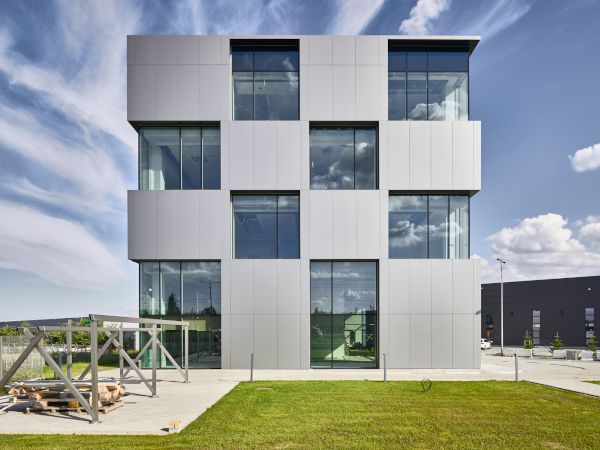Date: 20 February 2007
Solar control glazing for any transmittance classification, low emissivity glazing with insulation values down to 0.5 W/m�K, which are also for application in modern passive house architecture, as well as the temperable low-E coating "iplus ET" offer processors, architects, and planners solutions for practically any architectural challenge. The digitally printed panes for interior and exterior applications are newly on offer. One of the highlights: The intelligent LC glazing �ipaview CF switches from �transparent� to �nontransparent� within just seconds on the touch of a button.
For the energy efficiency of buildings, their outer shell is of particular importance. Glass facades let a lot of daylight into the building. At the same time though, the rooms have to be protected from overheating. The extensive Interpane product range for solar protection offers architects and planners suitable glazing in any transmittance category, from extremely low g-values (ipasol platin 25/14) to the highest light transmittance (ipasol neutral 73/39). For fa�ade design, the wide range of ipasol products also offers numerous possibilities: Anything from a neutral appearance (e.g. ipasol neutral 50/25) to lightly tinted glazing (ipasol shine 40/21), from low external reflection (e.g. ipasol neutral 52/29) to highly reflecting optics (ipasol platin 47/28) are all possible.
Energy savings with glass
The products around the coated basic glazing �iplus E� offer efficient thermal insulation for residential, commercial, and public buildings. Even the standard version provides excellent heat insulation (Ug = 1.1 W/m�K as per EN 673), high light transmittance (tL = 80 %), and a solar energy gain of 60 per cent (g-value as per EN 410). The top product iplus 3C E, which is suitable for passive houses, is made up of three panes and attains Ug-values down to 0.5 W/m�K.
The product range also comprises multifunctional glazing (iplus city E) for improved sound protection (Rw up to 38 db) and increased burglary-resistance (P4A safety rating as per EN 356), as well as the sound protection glazing iplus E/ipaphon. In order for basic glazing partners to be able to process the coated panes into tempered safety glass or heat-strengthened glass, Interpane has developed the temperable low-E coating "iplus ET".
Glass design for facades and interiors
Glass is increasingly being used for the design of interior rooms, furniture, and facades. Therefore, the Interpane safety glass plant in Hildesheim offers an extended product range. Here, for example, production techniques such as digital printing are combined with the advantages of ceramic colours. Durable, scratch and weatherproof glass elements for interior and exterior applications are the result.
With digital printing, it is possible to break down large designs into individual segments for on-glass printing. It is in this way that entire facades, for example, can be custom designed at drastically lower costs compared to conventional screen printing. Logos, pictures, or ornaments appear on the building, which are made up of individual glass elements.
The Hildesheim facility has the most modern plant of this kind in Germany. It prints panes up to a size of 2800 x 3700 mm and a thickness of 3 to 19 mm, at a resolution of up to 720 dpi.
Modern digital printing enables precision down to a tenth of a millimetre. This way it is possible to print two two-colour identical patterns on a pane, so that the graphics completely superimpose each other. If the colour white is printed on top of black, it is called "double vision". Since the eye will not become distracted by the white picture, it is easier to look from the inside out rather than vice versa.
"Transparent" or "nontransparent"
The controllable laminated LC glass �ipaview CF� offers both. On the touch of a button it switches from a milky translucent appearance to a transparent appearance in less than a second. It is thus the ideal glass wherever inside or outside exposure control is desired: In open-plan offices or conference rooms, as well as in museums, galleries, banks, or shops, or even outside advertising and furniture making.














Add new comment